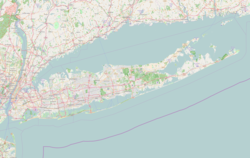Franklin Square, New York | |
|---|---|
 The Franklin National Bank (now a Chase bank), a historic landmark in Franklin Square, in 2016. | |
 Location in Nassau County and the state of New York. | |
| Coordinates: 40°42′6″N73°40′36″W / 40.70167°N 73.67667°W | |
| Country | |
| State | |
| County | Nassau |
| Town | Hempstead |
| Named after | Benjamin Franklin |
| Area | |
• Total | 2.88 sq mi (7.46 km2) |
| • Land | 2.88 sq mi (7.46 km2) |
| • Water | 0.00 sq mi (0.00 km2) |
| Elevation | 66 ft (20 m) |
| Population (2020) | |
• Total | 30,903 |
| • Density | 10,730.21/sq mi (4,143.09/km2) |
| Time zone | UTC−5 (Eastern (EST)) |
| • Summer (DST) | UTC−4 (EDT) |
| ZIP Code | 11010 |
| Area codes | 516, 363 |
| FIPS code | 36-27309 |
| GNIS feature ID | 0950629 |
Franklin Square is a hamlet and census-designated place (CDP) in the Town of Hempstead in Nassau County, on Long Island, New York, United States. The population was 30,903 at the time of the 2020 census.
Contents
- History
- Etymology
- Failed incorporation attempt
- Geography
- Demographics
- 2010 census
- 2000 census
- Arts and culture
- Landmarks
- Community organizations
- Government
- Parks and recreation
- Education
- Schools
- Library districts
- Media
- Infrastructure
- Notable people
- References
The area was originally known as Trimming Square [2] and then as Washington Square after President George Washington.




